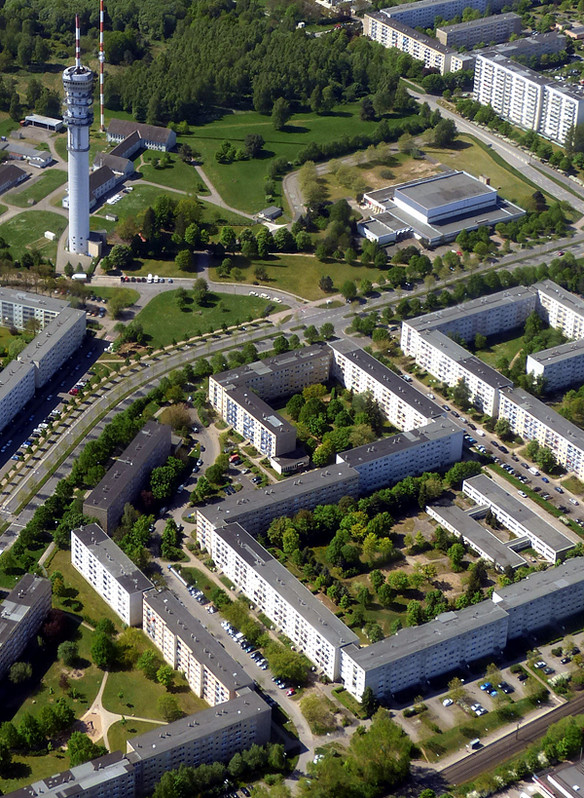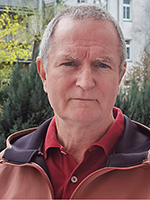Main Content
“The Large Housing Estate Does Not Exist. There Are Different Large Settlements!”
Interview with Spatial Planner Reinhard Huß

Schwerin-Mueßer Holz is one of three large housing estates in eastern Germany that were examined in the StadtumMig project. Urban planner Reinhard Huß has accompanied the development of the neighbourhood since the early 1990s. In this interview, he looks back and comments on the discussion about large housing estates as arrival neighbourhoods.
You came to Schwerin in 1993. What was your first impression of the large housing estates there compared to those you knew from West Germany?
I never actually made the comparison between the Federal Republic and Schwerin. It was a very exciting time because many things were possible relatively unbureaucratically. And I had never experienced anything comparable on this scale. I had previously been more concerned with workers' housing estates in the Ruhr area, which were built by the mines for their workers, and only marginally with large housing estates. So Schwerin-Mueßer Holz was something completely new for me.
Was there anything that totally surprised you when you came to Mueßer Holz?
Yes, the surprising thing about Mueßer Holz was how quickly people moved away. The population development was declining very strongly. We drew up a framework plan, but in the course of it the forecasts that were made in connection with it were actually already outdated. At that time we had StadtBüro Hunger as our framework planner, who saw the prefabricated housing estates as very viable for the future and was committed to preserving and valorising these estates. But the expectations he formulated were far removed from reality. The development was much more negative than predicted.
What factors contributed to this negative development in the neighbourhoods at the time?
The essential thing was that this housing construction is and was very strongly associated with the system of the GDR. It followed the claim “Everyone gets equal living conditions, the professor lives next to the worker. No one should be better off”. This was supposed to solve the GDR's housing problem. You also got a flat if you were a member of the party. There were many connections to the political system of the GDR. That certainly made it unattractive for many people to live there after reunification. Of course, there was also the urge to live more individually and to escape this same housing construction – into one's own home, into the city centre, into the redeveloped housing stock. Then the residential environment became increasingly unattractive because of the masses of cars flooding in. Infrastructure was quickly closed down, restaurants and the like. It was an exodus, driven by a variety of factors.
Could or should the municipality have acted differently in terms of urban policy at that time in order to maintain the attractiveness of the large housing estate? How do you see it in retrospect?
I don't think there would have been many other options. In my view, the biggest mistake that was made was the privatisation, especially in Mueßer Holz, which was not really discussed at all. There was a compulsion to privatise 15 % of the housing stock because of the old debt regulation. We talked to the housing companies about many things in the context of urban redevelopment, but not about where privatisation should have taken place. This severely limited the ability of the municipality and the housing companies to act, precisely in this neighbourhood, Mueßer Holz, where it would have been most urgently needed. The consequence for the district was that the deconstruction was very diffuse.
What changes do you think the immigration has brought about?
Well, the first immigration was the immigration of Russian Germans in the 1990s. At that time they were always seen as problematic. But I think that this group had a rather stabilising effect because they often had a good education, and also demands in terms of their housing situation and the development of their children and so on. Cultural life also came into the neighbourhoods. They quickly created a relatively large number of associations where they were culturally engaged. Mueßer Holz had already reached the low point of population development in 2011, but since then the population has increased. The influx of refugees from 2015 onwards increased the population growth considerably. In terms of urban planning, this did not result in such major changes. What was noticeable was that people wanted to be self-employed and tried to open small shops or snack bars. Then the residential environment was used more intensively. There was and is a bit more life outside, the parks and open spaces are used more. But beyond that, it hasn't had a big impact on the neighbourhood, no. Maybe there were a few more conflicts, now also with the Germans.
What were the biggest challenges for planning due to immigration? And what were the positive aspects?
The large housing estates came into focus because they were the place where these people could be accommodated. When they came in 2015, there was a lot of empty housing. The biggest impact was that housing that was supposed to be demolished was not demolished because it was needed for housing. This was perhaps an opportunity for the owners to make money from these flats again. For the urban planners it meant that plans to rebuild, to upgrade the district had to be postponed. That was certainly the most serious effect on urban planning at the time, that there was a postponement of five to seven years. Apart from that, it also meant a diversification of the population structure for the districts. The challenges were the associated tasks of integration, language acquisition, and integration into the labour market. And since these people now lived in these large housing estates, it was also concentrated there. This is also a thesis of the StadtumMig project, that large housing estates are becoming arrival neighbourhoods – and of course this is noticeable.
Is this reflected in the policies and strategies of the municipality?
I think it's very ambivalent. When I started here, the goal was to upgrade these neighbourhoods and establish them as residential areas in the city. Then – I would say shortly after the turn of the millennium – that was no longer the case. Politicians often assumed that we didn't need them any more. The population figures for Mueßer Holz were around 6,000, and there was hardly any willingness to invest in these districts, especially in Mueßer Holz. This changed at some point, so that the districts are now viewed positively. It was recognised that housing is needed in the long term. Due to the segregation study by Helbig and Jähnen, integration into the city and desegregation have again become the goal of urban policy. This segregation study has changed a lot – in terms of the perception of these neighbourhoods. But especially for Mueßer Holz it is completely unclear how to react. On the one hand, it is said that the segregation must be reduced, but on the other hand, one is a bit helpless because of the dimension of the problem.
How do you think large housing estates will develop in the future? And what political course do you think needs to be set here at city level or perhaps also at federal level?
I have my problems with the term “large housing estate”. There is no such thing as “the large housing estate” here in Schwerin and there will never be one anywhere; there are many different large housing estates.
What is needed now to help Mueßer Holz and counteract the greatest fears of social decline?
Investment in education infrastructure is important. At the moment, this is already happening quite well. The fact that the job centre and the employment agency are important institutions for the city and thus also focus a little more on the district is certainly also important. But points of attraction must also be created for the city as a whole. The opening of the television tower and the upgrading of the fire brigade museum would perhaps be a good possibility, because the district must be integrated more strongly into the city as a whole. It is also important that the residential environment is upgraded to eliminate the effects of deconstruction. However, this is a very difficult task due to the limited financial power of the city. In many places you can see the gaps left by the demolition. The district makes a very unfinished impression at one corner or another. New housing construction is also important, as a sign that it is possible to create new housing in this part of town. Until now, this district has always been seen from the point of view of deconstruction. I don't think that such new housing construction will contribute much to desegregation, because the numbers that are possible will be relatively small. But I think that in any case new housing construction is good for the image, to show: New housing is also possible in the district and not just demolition.
For the city as a whole, it is important that the differentiation that has taken place in recent years is perceived at all. That we no longer talk about “the large housing estate” or “the Plattenbau”, but that we take a closer look: How have urban districts and neighbourhoods developed? I think that's one of the main problems, that this differentiation still doesn't take place, but that there is still a great deal of generalisation. This usually leads to the worst image spreading to all, and not vice versa, that the best image pulls the others along.
The interview was conducted by Madlen Pilz and Matthias Bernt. The interview was conducted online on March 3, 2022. It is printed in an abridged and edited form.


